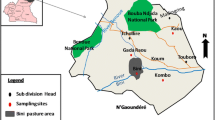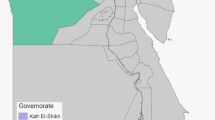Abstract
A study was made to determine the prevalence of camel trypanosomosis (surra) and its associated risk factors in Borena zone, southern Ethiopia during 2013–2014. A total of 2400 blood samples were collected and examined by the buffy coat and thin blood film laboratory methods, and data were analyzed using the SPSS statistical software. The overall prevalence of camel trypanosomosis in the area was found to be 2.33 %. Prevalence was significantly different among the surveyed districts (P = 0.000), the pastoral associations (F = 6.408, P = 0.000), altitudinal divisions (P = 0.000), age groups (P = 0.034), and between animals possessing packed cell volume (PCV) values greater than 25 % and less than 25 % (P = 0.000); whereas, prevalence of the disease was not statistically significantly different between the sexes (P = 0.311) and among the body condition score groups (P = 0.739). The PCV of trypanosome positive and trypanosome negative camels differ significantly (P = 0.001), and prevalence of trypanosomosis was seen to be negatively correlated with packed cell volume (r = −0.069, P = 0.000) revealing the effect of camel trypanosomosis on anemia state of parasitized animals. In conclusion, camel trypanosomosis is a serious and economically important disease hampering camel production and productivity in southern Ethiopia. Further studies involving more sensitive molecular techniques to reveal the precise magnitude of the disease and to identify the vector species of the parasite are recommended.
Similar content being viewed by others
References
Abebe W (1991) Practices and major health problems of cames in the Ogaden, Ethiopia. Eura J Agric Environ Sci 8:633–642
Afework Y, Mäser P, Etschmann B, Himmelstjerna GS, Zessin KH, Clausen PH (2006) Rapid identification of isometamidium-resistant stocks of Trypanosoma b. brucei by PCR –RFLP. Parasitol Res 99:253–261
Ahmed A (2008) Epidemiological studies (parasitological, serological and molecular techniques) of T.evansi infection in camels in Egypt. Vet World J 1(11):325–328
Anschau V, Perin AP, Tizatto MV, Miletti LC, Dafré AL (2013) Glutathione and iron at the crossroad of redox metabolism in rats infected by Trypanosoma evansi. Parasitol Res 112:2361–2366
Atarhouch T, Rami M, Bendahman MN, Dakkak A (2003) Camel trypanosomosis in Morocco l: result of first epidemiological survey. Vet Parasitol 111:277–286
Babeker EA, Hassab Elrasoul YM (2014) Incidence and treatment of camel trypanosomosis (Guffar) in west Omdurman in Sudan. J Vet Adv 4(6):582–593
Basaznew B, Ferew K, Mersha C (2012) Trypanomosis in camel in Delo-Mena District, Bale Zone, southwest Ethiopia. Acta Parasitol Glob 3(1):12
Bekele M (2010) An epidemiology study of major camel disease in the Borana Lowland, southern Ethiopia, Drylands Coordination Group Report No. 58, 09, 2010 Drylands Coordination Group c/o Miljøhuset G9 Grensen 9B N-0159. Oslo
Bhutto B, Gadahi JA, Shah G, Dewani P, Arijo AG (2010) Field investigation on the prevalence of trypanosomiasis in camels in relation to sex, age, breeds and herd size. Pak Vet J 30(3):175–177
Central Statistical Agency of Ethiopia (CSA) (2010) Agricultural sample survey report on live stock and live stock characteristics. 11(468):39
Da Silva AS, Belmonte Oliveira C, Adriel Zanette R, Morais Santurio J, Gonzalez Monteiro S, Wolkmer P, Machado Costa M, Paim F, Dos Anjos Lopes ST (2009) Lipid peroxidation in cats experimentally infected with Trypanosoma evansi. Parasitol Res 106:157–161
Delafosse A, Doutoum AA (2004) Prevalence of Trypanosoma evansi infection and associated risk factors in camels in eastern Chad. Vet Parasitol 119:155–164
Demeke G (1998) Prevalence of camel trypanosomes and factors associated with the disease occurrence in Leben District, Borena Zone, Oromia Region, Ethiopia. MSc Thesis, Addis Ababa University and Free University of Berlin
Dereje A, Tadesse B, Tajudin B (2014) Prevalence of camel trypanosomosis at selected districts of Bale Zone, southern Ethiopia. Sci Technol Arts Res J 3(3):103–106
Desquesnes M, Bossard G, Patrel D, Herder S, Patout O, Lepetitcolin E, Thevenon S, Berthier D, Pavlovic D, Brugidou R, Jacquiet P, Schelcher F, Faye B, Touratier L, Cuny G (2008) First outbreak of Trypanosoma evansi in camels in metropolitan France. Vet Rec 162:750–752
Dia ML, Van Meirvenne EM, Magnus AG, Luckins C, Diop AT, Jacquiet DP (1997) Evaluation of four diagnosis tests: blood smears, CATT, IFAT and ELISA-Ag in a study of the epidemiology of Trypanosoma evansi camel trypanosomosis in Mauritania. Rev Elev Med Vet Pays Trop 50:29–36
Eberhardt AT, Monje LD, Zurvera DA, Beldomenico PM (2014) Detection of Trypanosoma evansi infection in wild capybaras from Argentina using smear microscopy and real-time PCR assays. Vet Parasitol 202:226–233
Evans G (1881) On a horse disease in India known as “surra”, probably due to a haematozoon. Vet J Ann Comp Pathol 13:1–10, 82–8, 180–200, and 326–33
Fatihu MY, James AS, Abubaker MB (2000) Hematological data of healthy and natural Trypanosoma evansi infected camels (camelus dromedarius) in Sokato, Nigeria. J Protozool Res 10:1–5
Fikru R, Andualem Y, Getachew T, Menten J, Hasker E, Merga B, Goddeeris BM, Büscher P (2015) Trypanosome infection in dromedary camels in eastern Ethiopia: prevalence, relative performance of diagnostic tools and host related risk factors. Vet Parasitol 211:175–181
Food and Agricultural Organization of the United Nations FAO (2008) World camel population FAO statistics
Gebre S, Kaaya G (2008) Prevalence of camel ticks and haemoparasites in southern range lands of Ethiopia. Discov Innov 20:10–13
Gutierrez C, Juste C, Corbera JA, Magnus E, Verloo D, Montoya JA (2000) Camel trypanosomosis in the Canary Islands: assessment of seroprevalence and infection rates using the card agglutination test (CATT/T. evansi) and parasite detection tests. Vet Parasitol 90:155–159
Hagos A, Yilkal A, Esayass T, Alemu T, Fikru R, Feseha GA, Goddeeris B, Claes F (2009) Parasitological and serological survey on trypanosomiasis (surra) in camels in dry and wet areas of Bale Zone, Oromyia Region, Ethiopia. Rev Med Vet 160(12):569–573
Hussain HS, AI-Khalifa MS, Diab FM, Al-Asgah NA (1991) The blood parasites of local livestock in Saudi Arabia. Arab-Gulf J Sci Res 9(3):143–160
Kagunyu AW, Wanjohi J (2014) Camel rearing replacing cattle production among the Borana community in Isiolo County of Northern Kenya, as climate variability bites. Pastoralism 4:13
Kassa T, Tadesse E, Hassen C (2011) Prevalence of camel trypanosomosis and its vectors in Fentale district, South East Shoa Zone, Ethiopia. Vet Arh 81(5):611–621
Lemecha H, Lidetu D, Hussein I (2008) Prevalence and distribution of camel trypanosomosis in the semi-arid and arid Awash Valley of Ethiopia. Ethiop J Anim Prod 8:1–9
Luckins AG (1999) Trypanosomiasis caused by Trypanosoma evansi in Indonesia. J Protozool Res 8:144–152
Luckins AG, Dwinger RH (2004) Non-tsetse-transmitted animal trypanosomiasis. In: Maudlin I, Holmes PH, Miles MA (eds) The Trypanosomiases. Cabi Publishing, Trowbidge, pp 269–281
Mahmoud N, Abo-Shehadaa Hani A, Ghazi M, Zuher A (1999) Prevalence of Surra among camels and horses in Jordan. Prev Vet Med 38:289–293
Mohamed EW, Bernard F (2013) Surveillance of camel trypanosomosis inAl-Jouf region, Saudi Arabia. Camel-Int J Vet Sci 1(1):65–74
Ngaira JM, Bett B, Karanja SM (2002) Animal-level risk factors for Trypanosoma evansi infection in camels in eastern and central parts of Kenya. Onderstepoort J Vet Res 69(4):263–271
Njiru ZK, Ole-Mapeny JO, Ouma JM, Ndunģu W, Olaho Mukani IM (2001) Prevalence of trypanosomosis in camel calves: a pilot study in Laikipia District of Kenya. Rev Elev Med Vet Pays Trop 34:183–186
Pourjafar M, Badiei K, Sharifiyazdi H, Chalmeh A, Naghib M, Babazadeh M, Mootabi Alavi A, Hosseini Joshani-zadeh N (2013) Genetic characterization and phylogenetic analysis of Trypanosoma evansi in Iranian dromedary camels. Parasitol Res 112:899–903
Shah SR, Phulan MS, Memon MA, Rind R, Bhatti WM (2004) Trypanosomes infection in camels. Pak Vet J 24(4):209–210
Tadesse A, Omar A, Aragaw K, Mekbib B, Sheferaw D (2012) A study on camel trypanosomosis in Jijiga Zone, eastern Ethiopia. J Vet Adv 2(5):216–219
Tamarit A, Gutierrez C, Arroyo R, Jimenez V, Zagalá G, Bosch I, Sirvent J, Alberola J, Alonso I, Caballero C (2010) Trypanosoma evansi infection in mainland Spain. Vet Parasitol 167:74–76
Tekle T, Abebe G (2001) Trypanosomosis and Helminthoses: major health problems of Camels (Camelus dromedaries) in the southern Rangelands of Borena, Ethiopia. J Camel Pract Res 8(1):39–42
Woo PTK (1970) The haematocrit centrifugation technique for the diagnosis of African Trypanosomiasis. Acta Trop 27:384–386
Yadav SC, Kumar R, Kumar S, Tatu U, Singh RK, Gupta AK (2011) Identification and characterization of cysteine proteinases of Trypanosoma evansi. Parasitol Res 109:559–565
Acknowledgments
The Authors are grateful to the National Tsetse and Trypanosomosis Investigation and Control Center (NTTICC) for providing the required budget and logistics for this study. The cooperations of Borena zone Agricultural development office and camel herd owners of the study area are highly acknowledged.
Author information
Authors and Affiliations
Corresponding author
Ethics declarations
Conflict of interest
The authors declare that they have no conflict of interest.
Rights and permissions
About this article
Cite this article
Olani, A., Habtamu, Y., Wegayehu, T. et al. Prevalence of camel trypanosomosis (surra) and associated risk factors in Borena zone, southern Ethiopia. Parasitol Res 115, 1141–1147 (2016). https://doi.org/10.1007/s00436-015-4845-9
Received:
Accepted:
Published:
Issue Date:
DOI: https://doi.org/10.1007/s00436-015-4845-9




